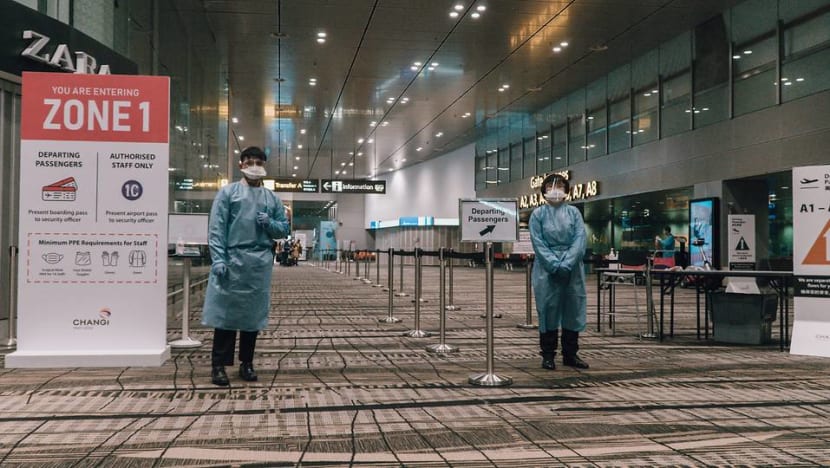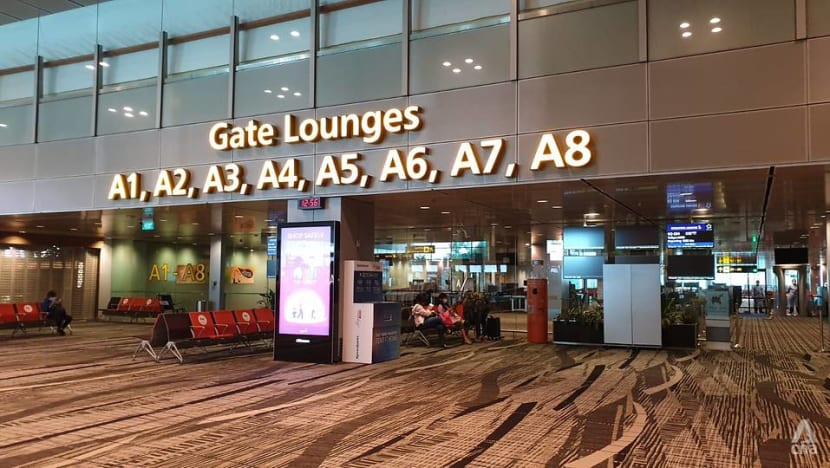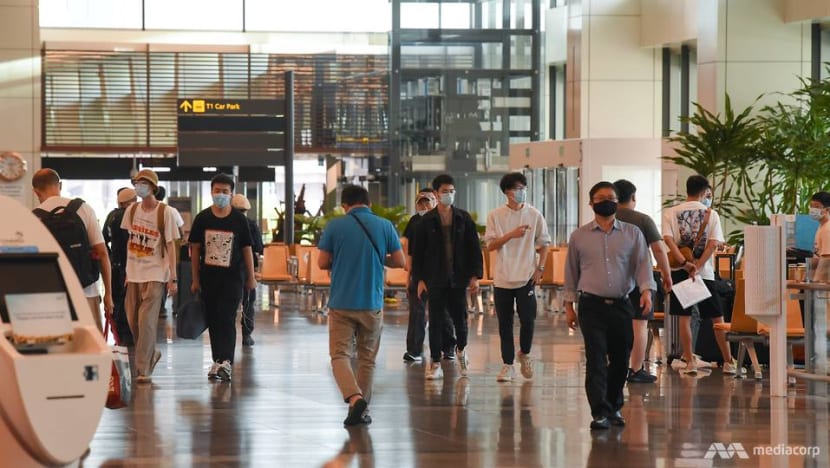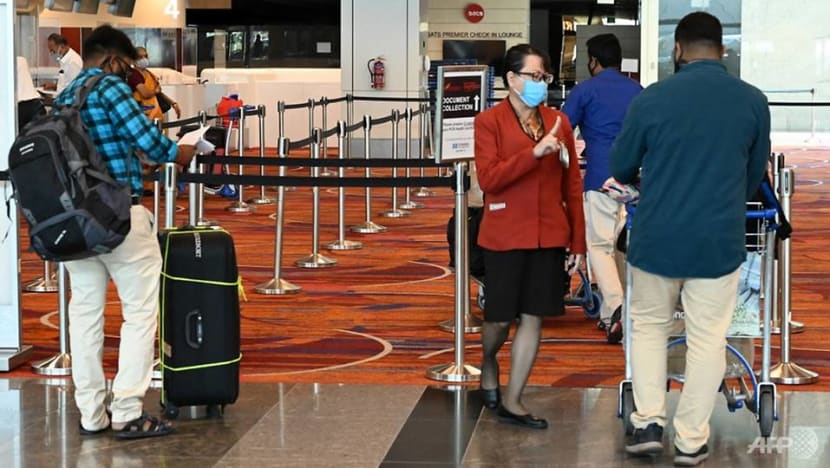commentary Commentary
Commentary: Targeted travel restrictions needed but careful not to undermine Changi Airport's connectivity
A handful of netizens have been calling for the aviation hub to close its doors to the world after a COVID-19 cluster there but IPS’ Faizal Yahya says be careful what you ask for.

Airport workers in Zone 1 wearing full personal protective equipment at Changi Airport Terminal 3, June 7, 2021. (Photo: Changi Airport Group)
SINGAPORE: The recent wave of infections in Singapore, which included a COVID-19 cluster at Changi Airport last month, has prompted some calls for the suspension of passenger travel at the airport altogether.
While many have called for an earlier tightening of restrictions of travel from certain places with surges in infections, which are reasonable, worryingly, there are some who have commented that Changi should also have been closed to inbound travelers to protect Singapore from bringing in COVID-19 cases into the country.
“Can’t they just close the border for 14 days?” asked one. “How about a complete ban” asked another.
While such calls are few and far between, they are alarming, do not understand the gravity of shutting off travel and should be addressed.
READ: Commentary: Costs of US travel bans come into sharper focus - for separated families, jobs and more
Even if a pause for 14 days eliminates imported cases completely, the risk remains after Changi reopens. Without a clear end in sight for this pandemic, staying shut until COVID-19 is brought to heel is not a viable option.
CRIPPLING CHANGI’S RECOVERY
Currently, due to COVID-19 restrictions on global travel, Changi only recorded 11.8 million passengers in 2020, a 82.8 per cent decrease compared to the 68.3 million in 2019.
Even though total passenger movement totalled 173,000 in April 2021, which is much higher than the low base of 25,200 a year ago when Singapore had a circuit breaker, Changi’s numbers have slowed to a trickle, at less than 5 per cent of pre-COVID traffic.
These have not factored in new travel restrictions imposed after a new wave of infections hit Singapore.
Airlines and airport leaders have already started adjusting to this reality of a collapse in air travel. The reduction in air travel has prompted major policy shifts such as the shelving of development for Terminal 5 for at least two years as air travel trends are analysed.
Singapore Airlines has also undertaken a major restructuring exercise.
COMPETITION IS RIFE
Even though international travel has been muted during COVID-19, Changi Airport's competitors have fared better, sustained by domestic traffic which make up almost 90 per cent of air travel in a pandemic year.

For 2020, the 11.8 million passengers that came through Changi were far fewer than the 43 million and 72.6 million respectively at Malaysian and Thai airports.
While Bangkok’s Suvarnabhumi and Don Mueang airports saw a 53 per cent dip in passengers over FY2020, they had a respectable 648,000 people coming through in September 2020, according to the Airports of Thailand. Out of these, 588,00 were domestic travel passengers.
Airports of Thailand also predicts that it should hit almost 80 per cent of 2019 passenger volume by the next fiscal year.
These regional airports have already given Changi a run for its money in attracting budget travellers pre-coronavirus, with Don Mueang’s emergence as the world’s largest low-cost air hub with multiple low-cost carriers (LCC) plying routes since 2015 and Malaysia building a low-cost carrier terminal at the Kuala Lumpur International Airport (KLIA) in 2014.
READ: Commentary: Why Singapore’s travel restrictions will keep changing for a while more
READ: Commentary: Airlines have little choice but to not be airlines for a few years
Further afield, the Gulf states with their airports in Abu Dhabi, Doha and Dubai are also gaining ground. Pre-coronavirus, airline seat count doubled in the Middle East between 2009 to 2018 to 264.3 million scheduled passengers departing from the region.
As at end-2020, Dubai welcomed 25.9 million people through its terminals, a third of the 86.4 million that passed in 2019.
“The Middle East sits in a unique position in dealing with the consequences of the pandemic and the airline losses from it”, Oliver Wyman Transportation and Services partner Michael Wette was quoted in an industry report as saying. “Mostly state-owned operators are somewhat protected from the short-term financial hit, given that the government will likely provide financial support.”
With sufficient oil and natural resources to cushion the blow, the Airports Council International forecasted on Feb 1 that over the next 20 years, total passenger traffic will grow at 5.2 per cent in the Middle East compared to 4.7 per cent in the Asia Pacific, with Saudi Arabia and United Arab Emirates leading the way.
THE IMPACT OF SCALING BACK ON AIR TRAVEL
With the aviation sector contributing 3 per cent to Singapore’s GDP and as many as 119,000 jobs, scaling back on passenger air travel is a risk the country can ill afford.
Travel bans to certain countries based on medical advice might have been necessary but has larger implications beyond the immediate drop in travel.

It is Changi’s excellent connectivity - based on its more than 400 flight destinations, flight frequency of an airplane arriving or departing from Changi every 80 seconds and the availability of more than 100 airlines that Changi serves – that makes Singapore a key aviation hub.
Maintaining long-haul connections with Europe and North America during the pandemic is necessary to sustain Changi’s air hub role in the region. Airlines that find new routes to bypass Changi for transit may find these alternatives eventually more attractive and may not return.
READ: Commentary: SIA's resumption of daily non-stop flights to key US cities - how necessary are they?
A long-term suspension of passenger travel at Changi, the de facto home of SIA, will inevitably harm the airline’s recovery and the fortunes of its more than 28,000 employees across the group. In addition, it will also hurt Singapore’s S$6.8 billion logistics sector, which hires more than 86,000 employees.
In the 2018 to 2019 period, Changi served 24 cargo airlines operating over 320 weekly scheduled freighter flights, linking Singapore to 48 cities. Passenger flights also carried freight in their under bellies.
Air connectivity is also critical to Singapore’s growth sectors like the pharmaceutical industry and e-commerce where portals here provide over 20,000 items from more than 800 brands.
KEEP CALM AND INCREASE PRESENCE
The cases of COVID–19 infections in Singapore and our key trading partners may continue to oscillate.

That is why instead of halting passenger flows, Changi has taken steps to improve public health safety through segregating workers into risk-based zones and passengers from places of different risk profiles among other measures.
Instead of knee-jerk reactions, the CAG must maintain visibility in key markets such as China and Indonesia through publicity and promotions so that it is well-placed to take advantage of the recovery once travel restrictions ease and vaccination rates go up.
For example, Changi has collaborated with Chinese mobile payment partners Alipay, WeChat Pay and UnionPay to launch quarterly shopping promotions targeting Chinese passengers.
READ: Commentary: The aviation sector should bounce back sooner than expected
As a key air hub in the region and within a key growth area for air traffic, Changi’s air connectivity should never be undermined because the loss of market share might not be regained.
No doubt steps must be taken to protect public safety. This is where responsive travel restrictions on high-risk destinations is needed when cases in other parts of the world spike.
But closure to passenger travel should not be an immediate option.
Dr Faizal Yahya is a Senior Research Fellow at the Institute of Policy Studies, Lee Kuan Yew School of Public Policy, National University of Singapore.












